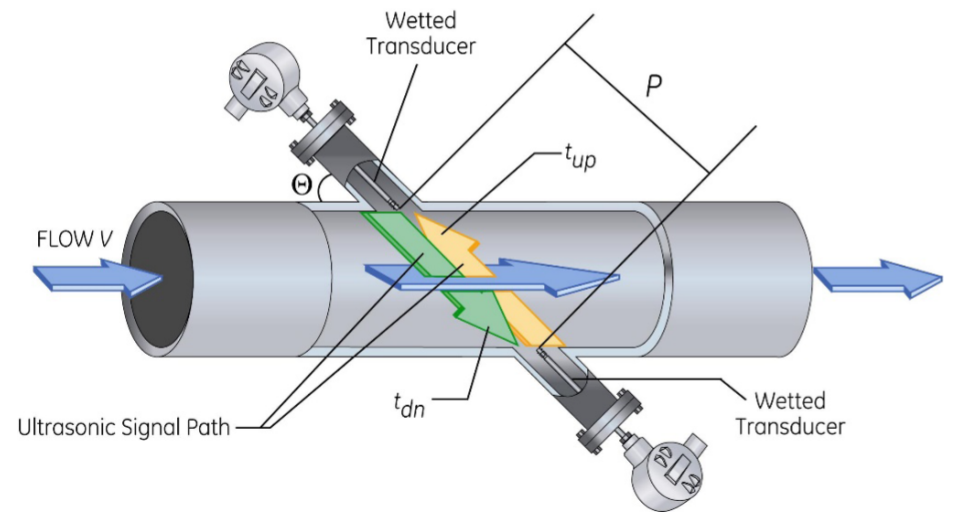
What are Flow Meters & How Do They Work?
Flow meters are measuring devices that are vital for many commercial and industrial functions. They have many applications, such as monitoring water leakage, wastewater treatment processing, and much more. Flow meters are integral to processes that contain liquids, gases, or vapor. Without the ability to monitor fluid flow, operators are often unable to control the throughput.
Flow meters from Panametrics improve plant safety, efficiency, and profitability through accurate and reliable flow measurements. This blog details flow meters so you can make an informed decision when selecting one.
A flow meter (also known as a flow sensor) is an instrument used to measure linear or nonlinear mass or volumetric flow of a liquid, gas, or vapor. These devices can measure the liquid, gas, or vapor flowing inside them during a set period of time. They can also measure the total amount of matter that has gone through them.
Panametrics offers both in-line and clamp-on flow meters. An in-line flow meter has a flow line installed in a process line and has a built-in flow conditioner that enhances the profile of the process liquid, gas, or vapor. With clamp-on flow meters, you can choose where to measure without disrupting production. They are easy to install without process shutdown and versatile for a variety of industries, substances, and pipe thicknesses.
All flow meters essentially have the same goal—to measure flow by recording how much liquid, gas, or vapor flows through a fixture. However, they do not necessarily go about it in the same way. It depends upon the type of flow meter you are using.
For instance, ultrasonic flow meters use ultrasound to measure the speed and volume of a liquid, gas, or vapor flowing through a pipe. An ultrasonic signal is sent to the material flowing downstream. Another signal is sent against the substance flowing upstream. This type of flow meter measures and compares the two ultrasonic transmissions. Using this data you can calculate different types of data, such as flow velocity or volume.
A magnetic flow meter, on the other hand, uses a magnetic field to measure the speed a liquid, gas, or vapor flows through a fixture, such as a pipe. When a substance, such as a fluid, flows through the created magnetic field, it generates voltage depending on the speed. Quicker fluid generates more voltage versus a slower flow.
Flow meters are crucial to many different industries. The following are three industries that rely on flow meters.
Oil and gas manufacturing require flow meters for many reasons. The main purpose is to measure the volume of the liquids and natural gases at many different points in the process. The oil and gas industries must properly measure flows regardless of whether they are pure or not as well as when flowing long distances.
The oil industry uses flow meters to measure the volume of oil flowing from one point to the other. The natural gas industry uses flow meters for the same reasons as the oil industry. They need flow meters to show and record how much gas is flowing and processing. Both oil and gas use flow meters to record and monitor their various systems and processes.
From wastewater to drinking water, flow meters are critical for the wastewater and water utilities industry. The water industry currently endures significant challenges caused by rapid urbanization, climate change, and rising customer demands; thus, the industry must accurately measure wastewater, such as sewage and other waste. Flow meters can prevent clogs in systems with thicker wastewater, such as sludge.
Water utilities also need flow meters for potable drinking water. They must accurately measure the correct amount of water that reaches each sector, such as in a city grid. This is very important so people have access to clean drinking water.
The food and beverage industry is usually characterized by a high water consumption and considerable waste water discharge volumes. For this reason, they face significant costs for water supply and trade effluent disposal.
Expenses for water supply and waste disposal, increase global competition in the food & beverage industry, rising of raw material costs, and energy supply rates drive the important of having more efficiently and optimized production processes.
Panametrics, a Baker Hughes business, is a leader in flare gas, steam, chilled, and portable metering applications. Our broad portfolio of in-line and clamp-on flow meters and readily available expertise enabled you to optimize your processes and meet your environmental and performance goals.
A Panametrics expert is ready to listen to your case. Contact us today to learn more about our flow meters and how they can help you meet your business needs.

